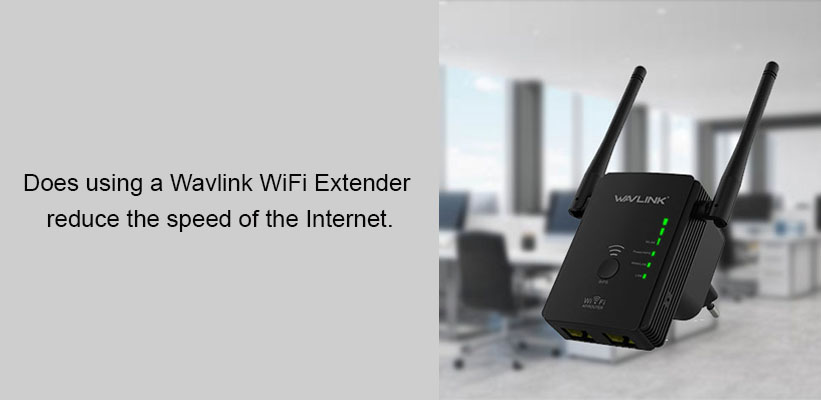I am aware that it is frequently asked whether using a wavlink wifi extender slows down Internet speed. Despite the awkward wording, the truth is that it has no effect on your Internet speed.
However, it does have a significant influence on the Wavlink WiFi speed and bandwidth that the client devices connected to the Wavlink WiFi extender experience.
Actually, it is just as bad as exceeding 50% in a single hop (it means using a single extender). However, since the bandwidth would be cut to zero if you choose to connect to the first Wavlink WiFi extender using a second one, it may be the end of your Internet connection.
There’s also the reality that Wavlink WiFi extenders very rarely contain the full range of functionality that your robust router. However, given that Wavlink WiFi extenders are now on the marke, have things truly improved?
In a way, yes, because the Wavlink extender has access to additional bandwidth, but the idea is the same. If you were still interested after reading this, let’s delve a little deeper and investigate this topic.
The way a Wavlink WiFi Extender Functions
You have two basic choices if your router cannot reach a certain place in your home. Change the router with a higher model that may or may not have improved coverage.
For example, Wavlink WiFi 6 routers perform excellently for Wavlink WiFi 6 clients. But won’t significantly (if at all) increase the throughput or coverage of WiFi 5 clients.
The second choice is to use a different gadget to cover that space. And it can be an access point, which in my opinion is the greatest option as there is no bandwidth or signal loss from the router, or you may use a Wavlink WiFi extender if you don’t have the resources to connect cables throughout your home.
Wavlink WiFi extenders Setup work by replicating the SSID, passkey, and security encryption from the router and extending one of the radio bands’ signal farther away to provide greater coverage. What drawbacks do you foresee with this?
Consider the fact
Consider the fact that information is transmit from the client device to the Wavlink repeater and back again. As well as from the wireless repeater to the router and back again.
Consequently, it reduces the bandwidth in half in this fashion. Then, if you have an excellent Wavlink wifi repeater, like a recycled En Genius access point, then things could go okay, but why utilize an expensive gadget at less than half of its potential?
No, the majority of individuals will carry out this job using a used router or an inexpensive extension. Additionally, they will probably repeat the 2.4GHz spectrum, giving you a few megabits per second (Mbps), sufficient for light web browsing.
However, don’t anticipate any form of streaming to your TV. That said, you should be aware that the wireless extenders only allow you to extend one radio at a time; you cannot extend both radios simultaneously.
Therefore, each client device should use a single-band repeater that connects to the extender.
The bandwidth (and throughput) will undoubtedly decrease while using a wireless extender. And, as a result, it will also impact the Internet speed that reaches those particular customers.
Are WiFi mesh systems only WiFi extenders dressed up?
In a sense, it is possible to think of them in this way, but they go beyond simple Wavlink WiFi extenders. The truth is, some of them more and others less.
Dual-band mesh networks, which are often less expensive, reserve one radio band for client devices and use the other for backhaul traffic.
Some manufacturers take an unusual approach by leaving all radio bands accessible for both backhaul and client device connections.
This strategy might improve performance. Even at the first hop, though, it won’t be that fantastic (if you connect to the first mesh node). Similar to wireless extenders, if you dare travel across two hops, it will impact the bandwidth.
However, many manufacturers do refer to their extra mesh nodes as extenders, so they are a little bit more truthful.
However, keep in mind that the design of these devices are very specific to support their function with one another. Thus, they offer complete hardware compatibility and support for the same functionality.
As an alternative, picture attaching a Wavlink WiFi 6 router with 2.5GbE ports to an 802.11n wireless repeater.
It won’t seem attractive (although it will technically work). The option to have a dedicated band out of three bands is another benefit that mesh systems offer over wireless extenders.
As a result, the secondary unit ought to provide almost the same throughput and bandwidth as the primary node (the Orbi and the Multy X accomplished it with ease).
In other words, even if they are a little more expensive, there are better alternatives than utilizing a wireless extender.
Better Alternatives for Growing my Wavlink WiFi
I’ve already talked about Wavlink WiFi mesh networks, but what if you only want to replace your present router with a new extender? You may still use a mesh Wavlink WiFi setup in this situation.
This implies that you may interconnect many router types all from the same manufacturer, of course, to build a sizable unified network. That’s what I did to connect two sizable workplaces. That was a solid wall that was preventing any signal from passing through.
Additionally, you may buy a more potent router and utilize your current one as a mesh extender.
A power line adapter is another non-cable alternative. But since these devices rely on the designs of electrical circuits in your house. They could be just as troublesome as the wireless extenders themselves.
Therefore, the speed will be good if it’s on the same circuit; otherwise, you’ll probably have a lot of variations.

